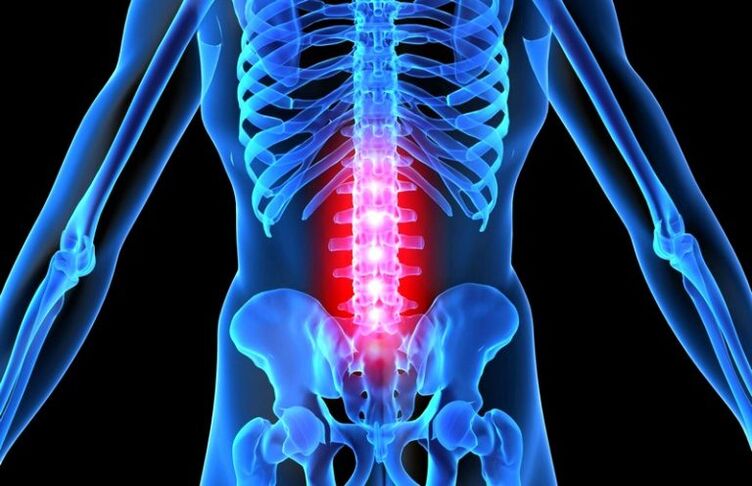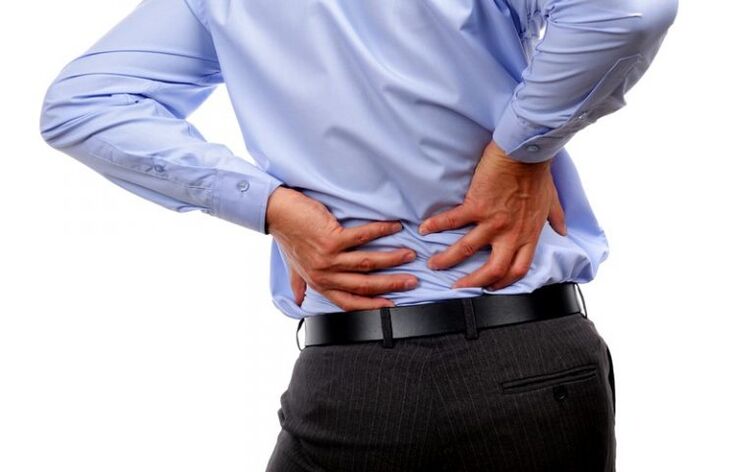
Translated from ancient Greek, osteochondrosis means ὀστέον - bone and χόνδρος - cartilage, and is characterized by complex degenerative changes in the articular elements of the skeletal skeleton. Almost every part of the skeleton is susceptible to this neurological disease. The thoracic and / or cervical vertebral discs may be in the affected area. However, it is osteochondrosis of the lumbar spine, whose symptoms and treatment are the most common in modern conditions, which is the reason for the discussion and attention of neuropathologists.
Pathogenesis, or development of inflammatory processes
Any organism in the process of growing changes its physiology. Thus, these changes occur in the vascular bed of the intervertebral disc on the skeletal bone. The supply of nutrients to the lumbar spine is complicated by various traumatic conditions and / or constant dynamic loads on this part of the spinal skeleton. Lack of nutrition with the required micro -elements is further complicated by osteochondrotic processes that lead to loss of elastic properties and strength of cartilage joints. With osteochondrosis of the lumbar spine, the symptoms of the disease are most active with asymmetric and irrational spinal muscle work, which is detected in a variety of conditions:
- inadequate heating of muscle tissue;
- wrong posture;
- intervertebral joint congestion due to excessive adipose tissue;
- use a mattress on a soft base during night rest;
- sharp mechanical and / or dynamic loads on the lumbar spine;
- physical stress;
- with exacerbation of chronic pathology.

The supply of nutrients to the lumbar spine is complicated by various traumatic conditions and / or constant dynamic loads on this part of the spinal skeleton.
If lumbar osteochondrosis is detected, symptoms of neurological disease caused by timely medical intervention can lead to more serious neurological pathologies, for example, sciatica, spinal hernia, intervertebral disc injury and other complications.
Why does lumbar osteochondrosis occur?
To date, the problem of diffuse transformation in the intervertebral space has not been fully studied. With osteochondrosis of the lumbar spine, symptoms of neurological pathological manifestations are often felt by middle -aged people from 35 to 45 years.

Nerve excess, stressful conditions can also cause the onset of disease.
It is at this most efficient age that static and dynamic stresses on the spinal space occur. However, according to expert observations, back pain is starting to bother more and more people from a younger age group. Thus, from 18 to 25 years of age, young people become patients of the neurological treatment department. This is due to poor physical activity, overweight, poor body posture and general deformity of the joints, which leads to lumbar osteochondrosis.
Symptoms and treatment of neurological pathology, it is desirable to identify and provide an adequate response in the early stages of the formation of the disease.
Other causative factors that cause lumbar spine osteochondrosis include:
- hereditary forms;
- inadequate provision of cartilage vessels with micronutrients;
- violation of metabolic processes due to various conditions;
- development of uneven musculoskeletal structure;
- inactive lifestyle;
- body disorders related to the work of the endocrine system;
- weakness of muscle structure due to the adverse effects of alcohol, smoking and other bad habits;
- as a result of various chronic pathologies;
- segmental instability of spinal space elements;
- nerve load, stress and other components.
However, when diagnosing lumbosacral spine osteochondrosis, neurological pathological symptoms in women can be diagnosed due to disorganization or development of disorders associated with hormonal changes. In the age period from 35 to 45 years, the female body begins to undergo significant physiological transformations, which affect the functional work of all bones and cartilage of the spine.
Signs of disease symptoms
With osteochondrosis of the lumbosacral region, neurological pathological symptoms make them feel pain in the lumbar region, which causes numbness, discomfort and pain in the lower back. Lack of adequate therapy can complicate the condition and cause atrophy of complete muscle structures in the lumbosacral spine. Increased pain can be provoked by a variety of factors, for example, sneezing, coughing, sharp rotations and lifting heavy objects. Cuts that occur in the lumbar region are most often given to the gluteal area and the calf area on the lower limbs. With lumbosacral osteochondrosis, the symptoms of neurological disease can be determined by the following signs:
- producing acute excruciating pain in the sacral spine area and in organs in the pelvic area;
- loss of sensitivity;
- discomfort in the muscles of the activated lumbar spine;
- hypotension and hypotrophy.

All of these symptomatic signs arise as a result of damage to the nerve roots in the intervertebral discs of the lumbar spine.
The stage of the disease
When diagnosing lumbosacral osteochondrosis, the symptoms and treatment of the disease depend on the stage of the inflammatory process. Therefore, based on the results of diagnostic examination, it is possible to determine some signs of inflammation of the lumbar spine:
- The first stage is determined by the sensation of mild pain in the lumbar zone, which increases under the influence of physical exercise. Only with a sudden movement, the patient feels a sharp, aching or dull ache in the lower back. In a relaxed state, pain does not occur.
- The second stage is determined when the distance between the vertebral discs decreases, due to compression, and the onset of degenerative-dystrophic formation on the annulus fibrosus. Sharp pain that radiates to the ankle area from the lower limbs, buttocks and outer thighs is caused by stretching of nerve endings between discs in the vertebral space.
- Destruction of the annulus fibrosus occurs in the third stage of the disease, and this is the best time for the formation of a hernia in the intervertebral disc. Severe pain in the lumbar region is permanent due to significant deformity of the lumbosacral spine.
- The last, fourth stage of lumbar spine osteochondrosis, its symptoms, treatment and recovery is the most difficult in the whole process of destruction of the musculoskeletal system. This stage of the disease leads to disability of the patient, as well as complete or partial instability.
However, any form of osteochondrosis should not cause fear and panic in a person; only adequate medical treatment is required.
Lumbar osteochondrosis: symptoms and medication
Based on the results of symptomatic signs and the determination of the appropriate diagnosis according to the stage and form of the disease, the specialist selects the appropriate drug treatment, which is based on the use of pharmacological combinations of various orientations. The main treatment objectives in problem solving are:
- slows down the degenerative-dystrophic process in the lumbar zone, through the implementation of appropriate therapeutic and prophylactic measures;
- elimination of dysfunction of spinal nerve endings;
- neutralization of painful sensations;
- restoration of muscle tone function of the lumbosacral region;
- the patient's return to an active life.
The age and sex of the patient, as well as the state of his endocrine system, play an important role in the selection of drug treatment methods.
The main emphasis in drug exposure is given to the elimination of pain with the selection of appropriate pharmacological analgesic agents. Anti-inflammatory drugs allow you to neutralize the damaging processes on muscle structures in the spinal area. The most effective pharmacological agents are the non-steroidal anti-inflammatory group.

The most effective pharmacological agents are the non-steroidal anti-inflammatory group.
With the efficacy of NSAIDs (non-steroidal anti-inflammatory drugs), anesthetics with hormone supplementation and / or paravertebral blockers are used. In addition, the complex drug process includes other types of pharmacological drugs, for example, sedatives, muscle relaxants, a group of drugs containing vitamins B1 and B12, which eliminate the effects of compression, and provide a supply of micronutrients to nerve tissue. Upon the end of the period of acute inflammation, treatment through drug therapy is completed, and other therapeutic and prophylactic measures are used during the remission period.
Prevention of lumbar osteochondrosis therapy
You should be aware that the treatment of osteochondrosis is a complex process that requires strict discipline, and strict adherence to all prescriptions of the attending physician. A prerequisite for full recovery of the body is to perform all stages of complex therapy, which include:
- Massage that helps relieve muscle pain, restores blood circulation in problem areas of the lumbar spine, relieves muscle tension in these areas of the body.
- Physiotherapy is a good method for recovery after an illness. The absence of side effects, the elimination of residual pressure in the lumbar region, this is the advantage of physiotherapy procedures.
- Manual therapy is able to act mechanically on the muscle tissues of the lower back in the measure of a meter and give them an improvement in all important processes.

It should be borne in mind that failure to comply with the recommendations of neuropathologists for complex therapeutic treatment of lumbar osteochondrosis is a possibility of a meeting with a surgeon. In 90% of cases, surgical intervention on the part of the spinal space is the result of a neglected disease state, and non -compliance with the recommendations of the attending physician.

























